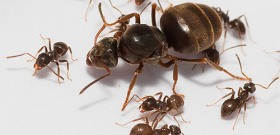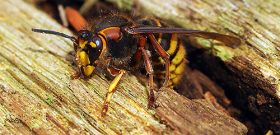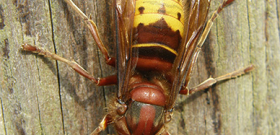
The uterus of hornets is the center and basis of the whole huge family. It is she who gives rise to a new nest: raises it on her own and feeds her first future helpers. But even after their appearance, the importance of the uterus does not decrease at all, because it will always be the only source of new individuals in the family.
The hornet uterus stands out noticeably among the entire family for its size, but this is just an external difference. The main feature of this only female capable of reproduction in the family is her life cycle, in which there are many interesting and surprising things.
On a note
All working individuals in the hornet nest, as well as in other social insects, are females.
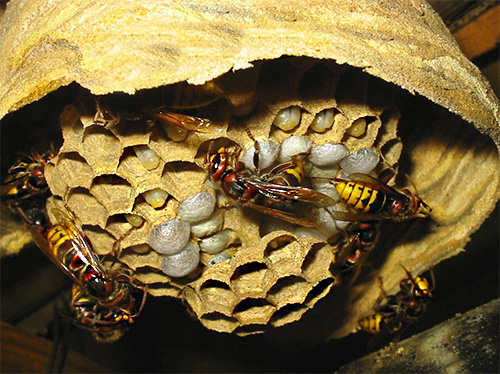
As a rule, in each family of hornets there is only one uterus. It is around her that the entire fast, but precisely organized life of the nest revolves. Only in certain species (and even then - occasionally) can polygyny be observed (from the English "poly" - many, "queen" - queen) - a phenomenon when several females lay eggs in the nest at once.
In the vast majority of cases, working hornets are not able to reproduce, however, in some species, certain hormonal changes may occur under the influence of environmental conditions. As a result of these failures, single females are able to lay unfertilized eggs, from which workers similar to them will be hatched.It is worth noting that, despite its gender and ability to reproduce, such a female hornet cannot be called a uterus.
Appearance, features and photos of the uterus of hornets
The hornet uterus is the largest individual in the family. For example, the main female of the European hornet reaches a length of 3 cm, while the indicators of a working individual are much more modest - only 2 cm. However, these figures are far from the limit: for example, in tropical hornets, the uterus can reach a length of 5, 5 cm
In the photo - the main female hornet in the nest:

But even despite the rather serious size, the uterus can easily be confused with an ordinary working individual: this becomes likely if the main female is alone in the field of view, is at a distance from the nest and there is simply no one to compare her with when she feeds or collects building material.
As a rule, the hornet queen flies at the beginning of spring, when she is forced to collect food for her offspring herself, or already at the end of autumn, after mating swarming.
On flowers, trees, and if it accidentally enters living quarters, the hornet uterus looks like an ordinary large wasp. In the photo below, it is clearly visible that she has a typical wasp waist, characteristic black bandages on her abdomen with a brown base, and a brown spot in the form of a horseshoe on the back:
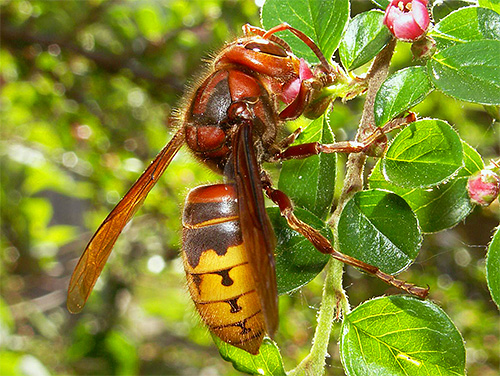
Thus, in the vast majority of cases, the hornet's uterus has the same color as all other inhabitants of the nest. That is why, even despite the large size, in the conditions of a large concentration of working individuals, it will not be easy to find their queen.
In the photo - the uterus of hornets in the center of the family:
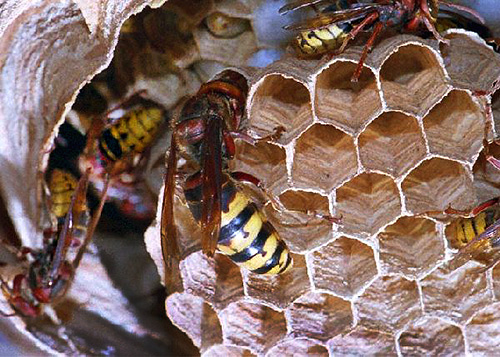
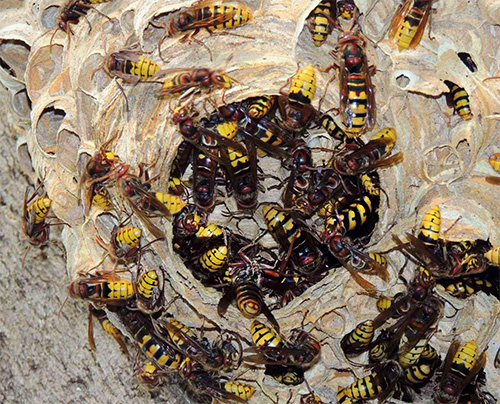
It is interesting
The original principle of visual masking of insects is based on a combination of contrasting colors in coloring.When a predator wants to catch one individual from a large group, the chaotic movement of hundreds of striped bodies creates chaotic ripples in his eyes, among which it is difficult to single out a specific victim. An excellent example of this principle are zebras, which, for this reason, have a characteristic striped outfit. The hornets, on the other hand, got their color from the peaceful ancestors of the bees, who were forced to defend themselves from predators with all their might.
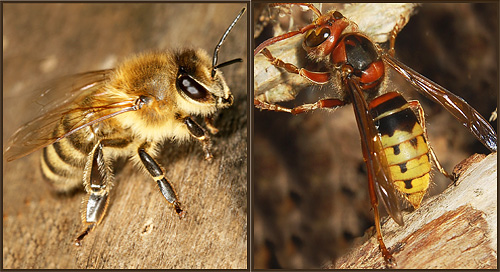
It is worth noting that the hornet uterus is similar to members of its family not only in color - it is also “poisonous” and stings with the same force as a working individual.
The beginning of the life of the uterus
The future founder of a new family of hornets is born in late August or early September. A month before, her mother - the old uterus - begins to lay fertilized eggs, from which females capable of reproduction emerge. At the same time, the old hornet queen lays unfertilized eggs, from which males hatch.

By the time of the mating period, the hornet family is already very large: the number of working individuals in it reaches several tens, or even hundreds. And the nest itself at this stage grows to an impressive size. So, for example, the dwelling of an ordinary hornet can reach a length of 70-80 cm and weigh up to 10 kg!

All larvae (including young queens) are fed exclusively on meat food - other insects. However, even after emerging from pupae, working individuals can feed the successors of the genus for some time.

By the time the females capable of reproduction appear, the old uterus has already exhausted its potential and practically stops laying eggs.Therefore, it often happens that the working hornets drive her out of the nest or even kill her.
In the photo - the old uterus of hornets:
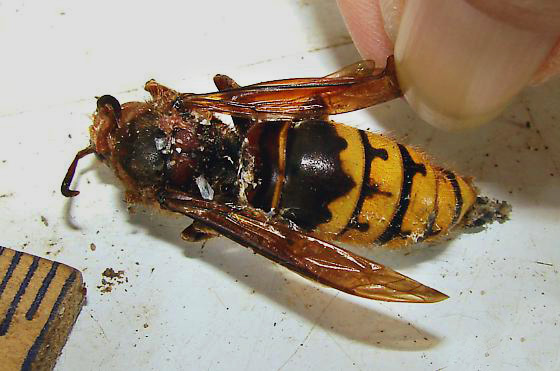
When there are too many young females and males in the nest, they fly out of the mother's house, swarm and mate. The males then die within a few days, while the females may still hunt for some time or look for sweet fruits to feed on. However, with the approach of cold weather, they still find suitable shelters for wintering, in their opinion: under stones, in cracks in the bark, hollows, and also in nests in which all working individuals have already died out.
It is interesting
If the female has chosen an already used nest as a refuge for wintering, then it is likely that she will not live until the end of winter. Usually, working hornets live in old nests before the onset of cold weather, which do not let the youth that have already flown back back. But there is another reason for the low survival rate: sometimes working individuals die out in the nest due to tick and bacterial infections, which do not spare the young females hiding here.
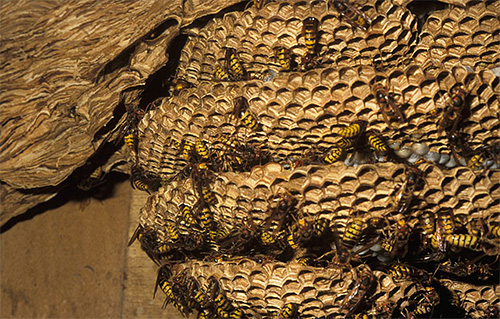
The wintering stage is absent in tropical hornets: these females immediately establish new nests after mating. But sometimes they also return to their native family, initiating the expulsion of the old queen, and begin to rule the already developed nest.
Wintering is the most difficult stage
During wintering, all processes in the body of a young female slow down, so she spends the energy reserves accumulated over autumn as economically as possible. However, a significant number of females die at this stage from frost and predators - insectivorous mammals and birds.
The most protected are those hornet queens that hibernate on trees under large layers of bark: birds cannot always penetrate under them, and there are not so many other insect hunters at this time.
In the photo - the hornet's uterus during wintering in the gap between the logs:

Founding a new family
In the spring, with the onset of warm weather, the young female awakens from her winter torpor and actively feeds for several days to restore her strength.
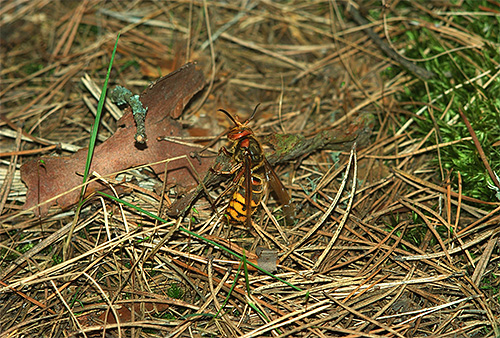
The basis of its diet during this period is made up of other insects, and sometimes berries and fruits thawing from under the snow.
At the same time, the future queen is looking for a convenient place to place a nest: it can be just a strong branch, or a hollow, a crevice in a rock or a hole in a sandy slope. The uterus collects soft young bark from tree branches, chews it and builds the first combs in which it immediately lays eggs.
In parallel, the young uterus continues to create a new nest of hornets, building on the primary structure. The home of insects, thanks only to the forces of one founding queen, can sometimes reach the size of half a soccer ball.
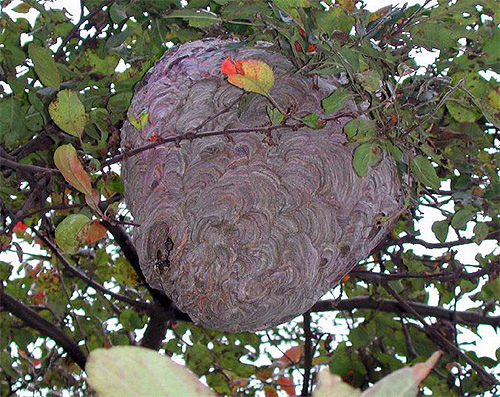
When the first larvae hatch from the eggs, the uterus itself catches insects for them and feeds its future helpers. When the first working individuals appear, the hornet queen practically stops flying, all her activity is reduced only to laying eggs. Insect workers take on all the responsibilities for obtaining food for the larvae and queen, caring for them, as well as building new combs.

It is interesting
Among all 23 types of hornets, there is one that is radically different from its relatives - the black hornet.Its females exhibit so-called nest parasitism: they do not build nests and do not feed the first larvae. All spring, females simply feed carelessly, and at the beginning of summer they find a family of ordinary hornets, penetrate their nest, kill the queen and, disguised as pheromones, impersonate her. Of course, such a “trick” is very dangerous, because working individuals can kill the alien even before it reaches their uterus. However, such a seizure of power is often successful, and the workers look after the new queen as diligently as they looked after the previous one. Of course, new - black - hornets will come out of the eggs laid by her, which will gradually replace the old owners of the nest.
hornet queen
In the nest, the uterus of the hornets is indeed a real queen. The whole family lives around her: she is fed, the eggs laid by her are picked up and carefully spread over the combs, she is protected to the last in case of an attack on the hive. The uterus, in turn, provides a constant population growth in the nest, laying several dozen eggs every day.

The connection of the uterus with the working hornets occurs through chemical odor signals. If something happens to her, after a few seconds all the hornets that are in the nest know about it.
As mentioned above, at the peak of the power of the family (for European hornets - around August), the uterus begins to lay fertilized eggs, from which, due to hormonal mechanisms, females and males capable of reproduction develop. This stage is of great importance for each type of hornet, but for any single uterus, it means the approach of her death ...
Old age and the decline of the hornet empire
Having begun to lay eggs, from which males and females capable of reproduction will be hatched, the uterus practically loses its egg-bearing potential. For a few more weeks, she will continue to provide the nest with offspring, but the number of eggs will inexorably decrease. And after a short time, the queen will completely stop the production of eggs.
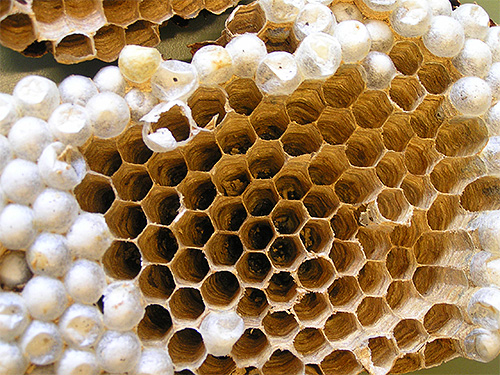
By this time, the vital resources of the uterus are depleted: it grows decrepit, barely crawls, loses part of the hairs on the body. Working individuals practically cease to feed it, and there are very few of them themselves.
After the departure of young insects from the nest, mites and other hornet parasites often begin to multiply here, from which the uterus often dies. But even if there is no infection in the hive, when frost sets in, all remaining working individuals and the old queen will die.
Thus, the life of almost every hornet uterus consists of several main stages:
- exit from the larva;
- pairing;
- wintering (tropical species do not have this stage due to climatic conditions);
- construction of the first combs of the future nest (the exception is the black hornet) and the laying of the first larvae;
- providing the family with offspring (including both females and males capable of reproduction);
- death.
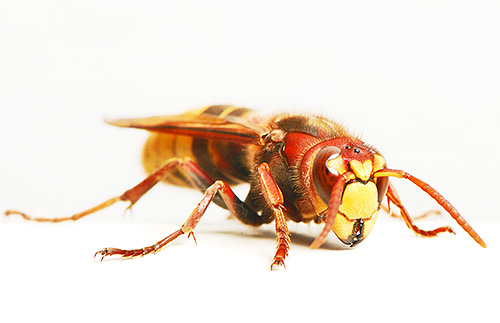
Nevertheless, not everything is so sad: somewhere around the nest, young, strong and fertilized females are already finding winter apartments for themselves, which in the spring will start the cycle anew, continuing to write the history of the species with their unceasing work.
Interesting video: how hornets take care of their larvae in the nest

